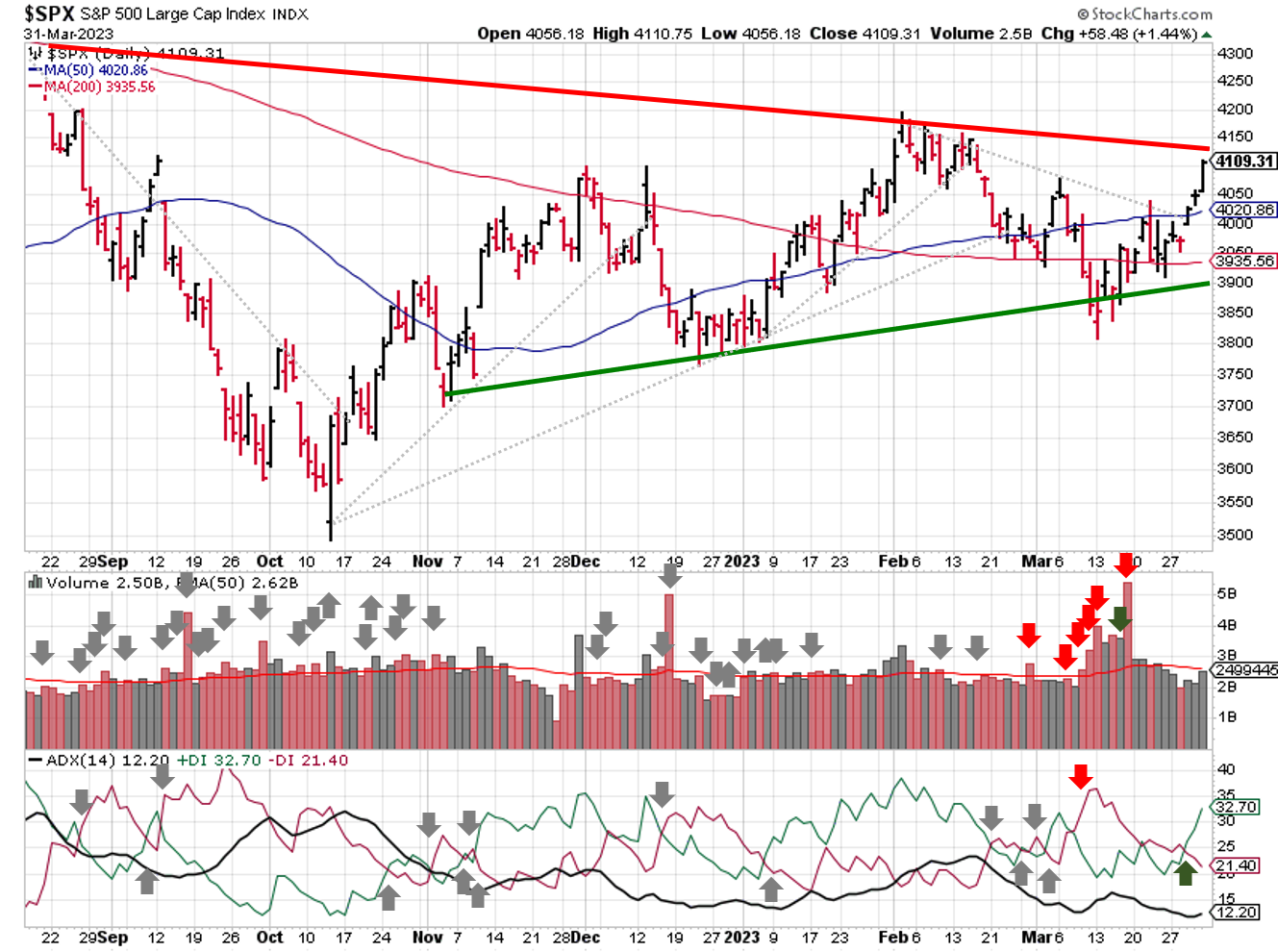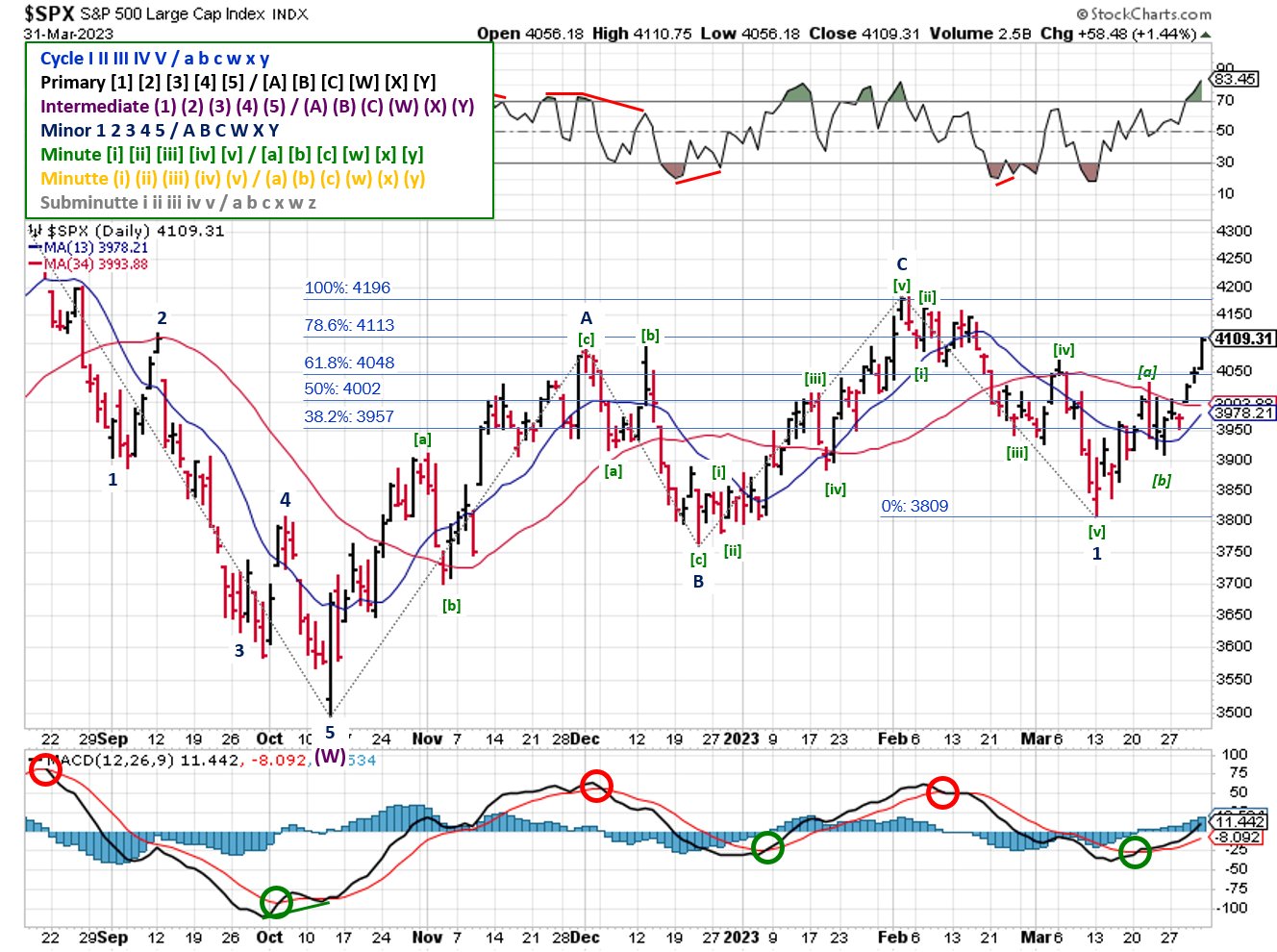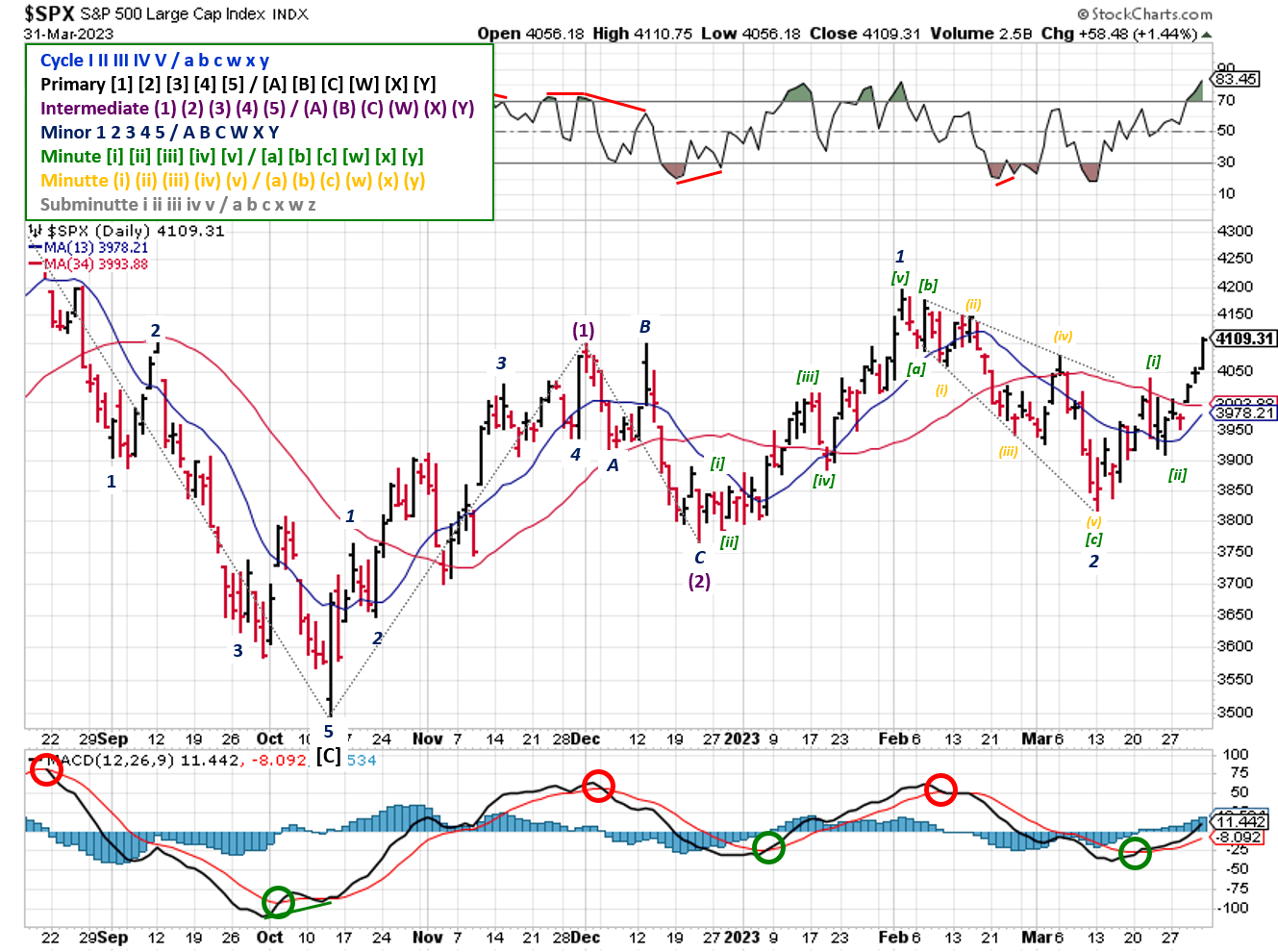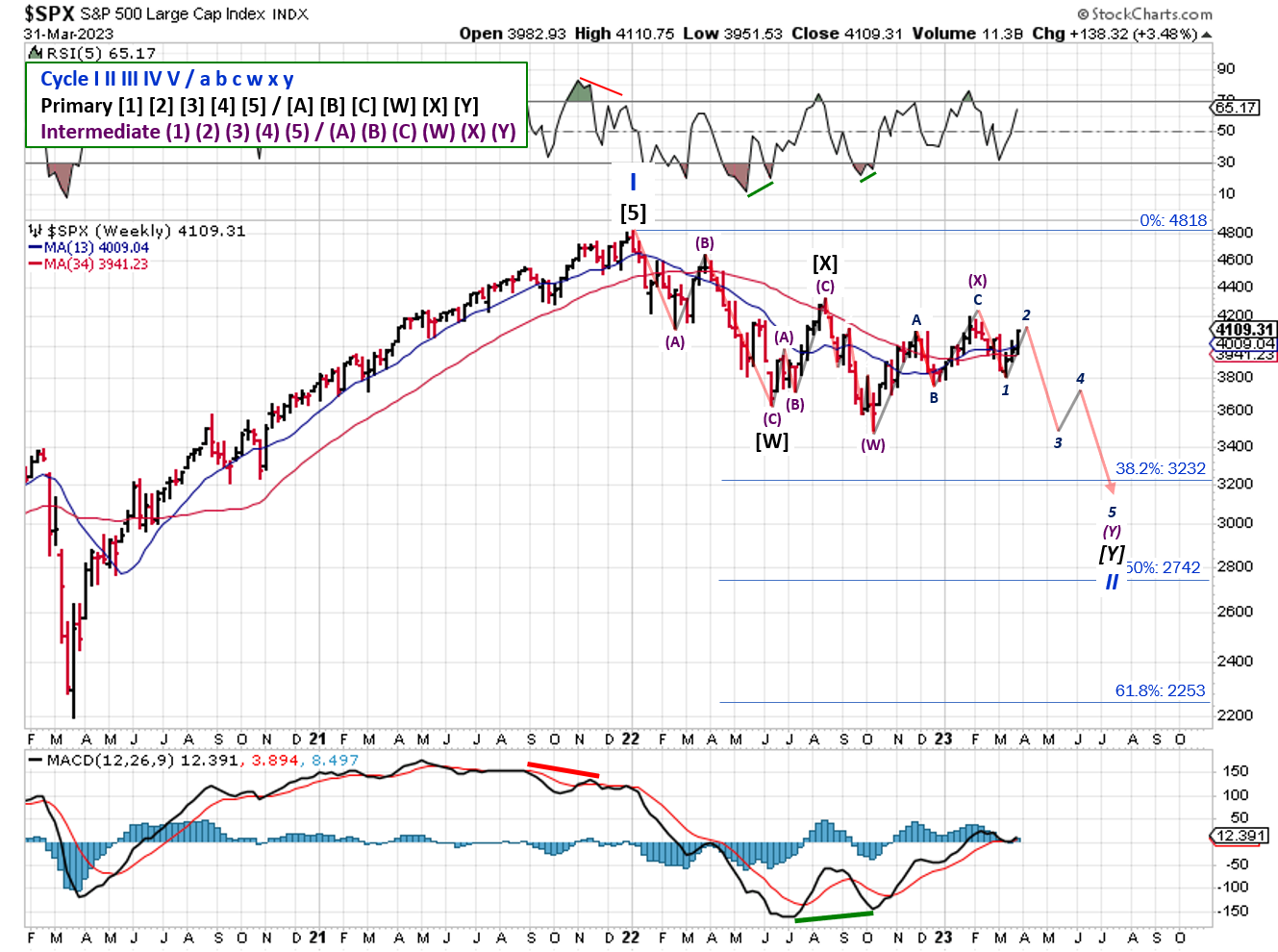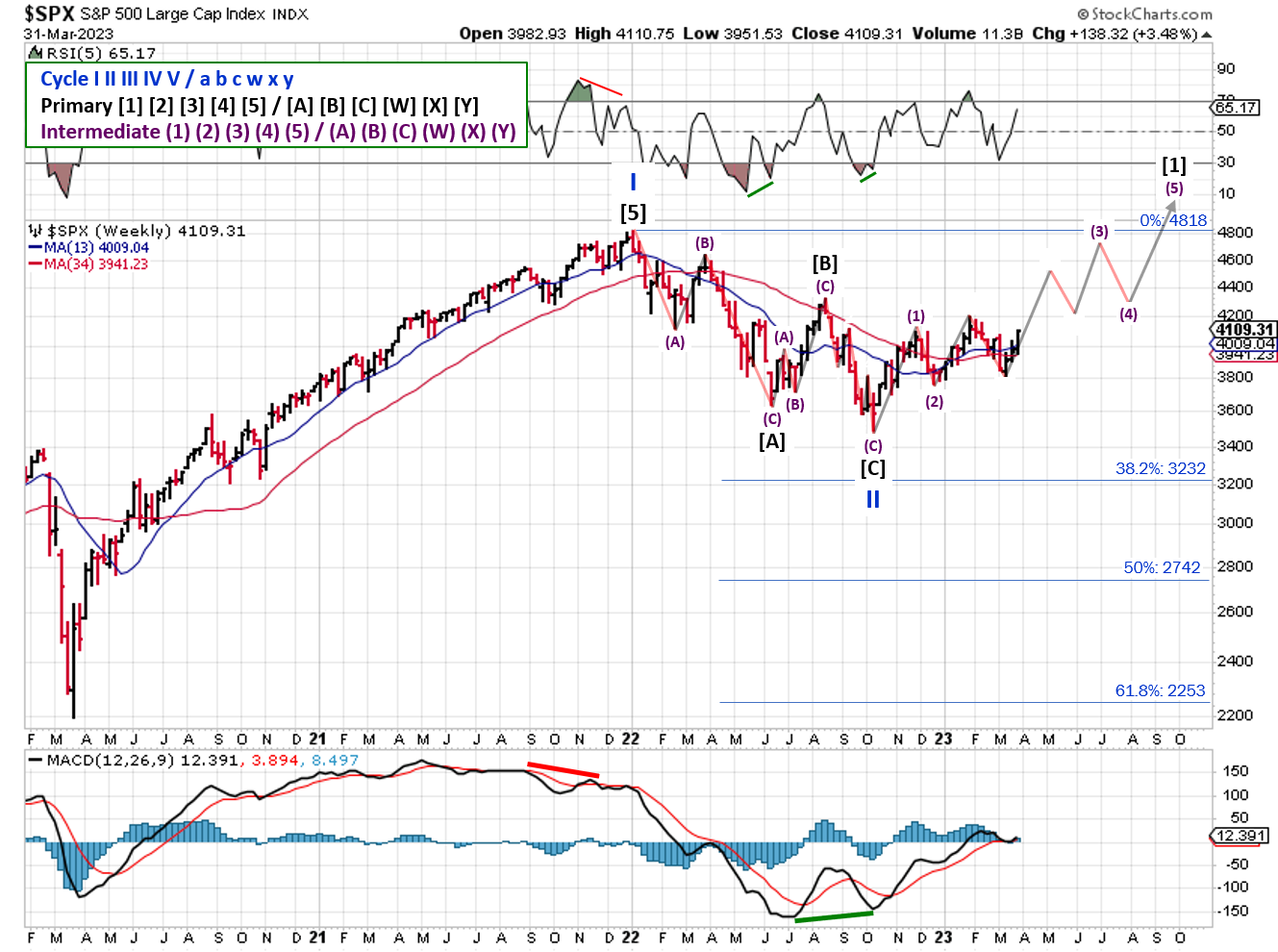Stock Market Outlook
For The Week Of April 4th = Downtrend
INDICATORS
-
ADX Directional Indicators: Uptrend
Price & Volume Action: Mixed
Elliott Wave Analysis: Mixed
The S&P500 ($SPX) rose 3.5% for the week, rallying past the 50-day moving average, and breaking the trend of lower highs since early February. Trading volume fell to below average levels. The index closed out the first quarter up 7%, with that entire gain coming within the past 3 weeks.
2023-04-02-SPX Trendline Analysis - Daily
The ADX directional indicators flipped to bullish on Wednesday, though the overall trend remains weak with reading near 12.
Price/volume moved to mixed on Wednesday; price closed above the 50-day moving average, but trading volume was below average. Thursday and Friday's price gains also occurred on low volume, indicating those moves weren't supported by institutional buying. Look for a gain of 1.5% or more on above average trade volume to signal a confirmation of an uptrend.
Elliott Wave remains mixed, with 3765 and 4196 still the proverbial lines in the sand. Last week’s analysis bore out, with the SPX rising towards 4200. This week, the MACD remains bullish but the RSI(5) is overbought. This suggests a drop in the days ahead; probably back to the 4000 level. Updates to the monthly charts are at the end of the post.
2023-04-02- SPX Elliott Wave Analysis - Daily - Primary Y (Bearish)
In the bearish count, the index closed within the typical completion zone (61.8%+) for a second and suggests March's bear market rally is nearly complete.
2023-04-02- SPX Elliott Wave Analysis - Daily - Primary 1 (Bullish)
The bullish wave count suggests that a move to the downside will be short-lived.
COMMENTARY
Last week's data releases maintained the trend of "mixed bag" reports; overall unemployment remains low, while inflation continues to rise, albeit not as much verses the prior month / year.
Short trading week ahead, with U.S. stock markets closed for Good Friday on the 7th. Earnings season kicks off the following week, with reports from JPMorgan Chase (JPM), Wells Fargo (WFC) and Citigroup (C).
With mixed signals, mixed bag datasets, and corporate quite periods ahead of earnings, capital flows (i.e. momentum) will be the name of the game. So watch out for reversals and whipsaws over the next two weeks.
Best To Your Week!
P.S. If you find this research helpful, please tell a friend.
If you don't, tell an enemy.
Sources: Bloomberg, CNBC, Federal Reserve Bank of St. Louis, Hedgeye, U.S. Bureau of Economic Analysis, U.S. Bureau of Labor Statistics
Long-term Elliott Wave Count Updates
2023-04-02- SPX Elliott Wave Analysis - Weekly - Primary Y (Bearish)
2023-04-02- SPX Elliott Wave Analysis - Weekly - Primary 1 (Bullish)
Share this Post on:

How to Make Money in Stocks: A Winning System in Good Times and Bad.
It's one of my favorites.
I regularly share articles and other news of interest on:
Twitter (@investsafely)
Facebook (@InvestSafely)
LinkedIn (@Invest-Safely)
Instagram (@investsafely)
Invest Safely, LLC is an independent investment research and online financial media company. Use of Invest Safely, LLC and any other products available through invest-safely.com is subject to our Terms of Service and Privacy Policy. Not a recommendation to buy or sell any security.
Charts provided courtesy of stockcharts.com.
For historical Elliott Wave commentary and analysis, go to ELLIOTT WAVE lives on by Tony Caldaro. Current counts can be found at: Pretzel Logic, and 12345ABCDEWXYZ
Once a year, I review the market outlook signals as if they were a mechanical trading system, while pointing out issues and making adjustments. The goal is to give you to give you an example of how to analyze and continuously improve your own systems.
- 2015 Performance - Stock Market Outlook
- 2016 Performance - Stock Market Outlook
- 2017 Performance - Stock Market Outlook
- 2018 Performance - Stock Market Outlook
- 2019 Performance - Stock Market Outlook
- 2020 Performance - Stock Market Outlook
IMPORTANT DISCLOSURE INFORMATION
This material is for general communication and is provided for informational and/or educational purposes only. None of the content should be viewed as a suggestion that you take or refrain from taking any action nor as a recommendation for any specific investment product, strategy, or other such purpose. Certain information contained herein has been obtained from third-party sources believed to be reliable, but we cannot guarantee its accuracy or completeness.
To the extent that a reader has any questions regarding the applicability of any specific issue discussed above to his/her individual situation, he/she is encouraged to consult with the professional advisors of his/her choosing. Invest Safely, LLC is not a law firm, certified public accounting firm, or registered investment advisor and no portion of its content should be construed as legal, accounting, or investment advice.
The material is not to be construed as an offer or a recommendation to buy or sell a security nor is it to be construed as investment advice. Additionally, the material accessible through this website does not constitute a representation that the investments described herein are suitable or appropriate for any person.
Hypothetical Presentations:
Any referenced performance is “as calculated” using the referenced funds and has not been independently verified. This presentation does not discuss, directly or indirectly, the amount of the profits or losses, realized or unrealized, by any reader or contributor, from any specific funds or securities.
The author and/or any reader may have experienced materially different performance based upon various factors during the corresponding time periods. To the extent that any portion of the content reflects hypothetical results that were achieved by means of the retroactive application of a back-tested model, such results have inherent limitations, including:
Model results do not reflect the results of actual trading using assets, but were achieved by means of the retroactive application of the referenced models, certain aspects of which may have been designed with the benefit of hindsight
Back-tested performance may not reflect the impact that any material market or economic factors might have had on the use of a trading model if the model had been used during the period to actually manage assets
Actual investment results during the corresponding time periods may have been materially different from those portrayed in the model
Past performance may not be indicative of future results. Therefore, no one should assume that future performance will be profitable, or equal to any corresponding historical index.
The S&P 500 Composite Total Return Index (the "S&P") is a market capitalization-weighted index of 500 widely held stocks often used as a proxy for the stock market. Standard & Poor's chooses the member companies for the S&P based on market size, liquidity, and industry group representation. Included are the common stocks of industrial, financial, utility, and transportation companies. The S&P is not an index into which an investor can directly invest. The historical S&P performance results (and those of all other indices) are provided exclusively for comparison purposes only, so as to provide general comparative information to assist an individual in determining whether the performance of a specific portfolio or model meets, or continues to meet investment objective(s). The model and indices performance results do not reflect the impact of taxes.
Investing involves risk (even the “safe” kind)! Past performance does not guarantee or indicate future results. Different types of investments involve varying degrees of underlying risk. Therefore, do not assume that future performance of any specific investment or investment strategy be suitable for your portfolio or individual situation, will be profitable, equal any historical performance level(s), or prove successful (including the investments and/or investment strategies describe on this site).
